The proliferation of different devices over the past two years has presented fantastic opportunities for marketers, but also a number of significant challenges. New advertising options, different operating systems and screen sizes and changing user behaviour means that staying ahead of the curve is increasing difficult.
For the luxury sector, which prides itself on innovation as well as consistent, high quality brand experiences, these challenges are even more pronounced. However the interactive, immersive nature of multi-device marketing also makes it hugely attractive for luxury marketers – and here are the ways to get it right.
1. User experience is vital. Think how consumers use the device. Is it touchscreen? Or do they use a stylus? What size is the screen? How powerful are the devices? All will affect the message and creative of the ad – for example, we designed an interactive shopping tool for one client that allowed customers to personalise products before buying. This had to be usable across desktops, laptops, tablets and smart-phones, particularly iPad and iPhone. Therefore, the interface had to work just as well using a mouse as using touchscreen and had to use html5 rather than flash. Decisions like this can make or break a campaign and avoid expensive re-work later on in the project.
2. Make it interactive. The digital world is an interactive one: people use their phones and tablets as tools and are used to being able to control and manipulate the environment. Making the ad interactive will keep users more engaged and result in a more lasting message retention and action, with reports suggesting anywhere between a 3x – 9x uplift as a result of interactivity.
3. Keep it high quality. Apple has re-set the benchmark for what people expect in terms of finish and user experience, from transitions to creative. It is vital for mobile advertising to reflect this high standard and this is even more pronounced for luxury brands, where the finish will reflect the brand’s attention to detail and values.
4. Let online and offline combine. The combination of a camera and high quality video screens has created a wealth of exciting opportunities for Augmented Reality advertising. Luxury brands like Dunhill have been quick to utilise this technology, bringing their print ads to life with video simply by holding the device over the ad. The possibilities for this are pretty huge, such as being able to view a whole range of clothes from a single billboard, or even purchase or buy from a printed ad.
5. Consider multi-device usage. One of the most fascinating behavioural trends to appear as a result of tablets and smartphones is simultaneous multi-device usage, or put simply, browsing the web whilst watching TV. A recent Nielsen report claims 42 percent of tablet and smartphone users use their devices whilst watching TV every day, with a further 28 percent doing it several times a week. A significant 20 percent of those use it to search for information related to adverts, meaning that planning a multi-device strategy is vital to capitalise on this audience.
6. Make sure the whole journey is optimised. There is nothing worse than a great mobile ad linking through to a website that hasn’t been optimised for the device. It’s totally pointless and actually does more harm than good by being disappointing for the user. I’ve seen some horrific examples of this recently, with QR codes opening up websites that don’t even render properly on mobile Safari. It’s a guaranteed way to disappoint and lose potential customers.
7. Keep file size lean. Load times for ad content and landing pages is critical, as many users will interact with ads over a 3G network where long load times will be a sure fire way to cause drop off. This can be a real challenge considering the high quality finish required for luxury advertising, especially using rich media like video. However luxury customers are used to getting what they want quickly and are time poor, so creating a masterpiece with a huge load time will be counter-productive.
8. Make it social. Engaging brand experiences will be share-worthy, particularly for much-loved luxury brands, so giving users the tools to be able to share easily will help viral spread. All evidence shows that peer recommendation is by far the most effective form of marketing, but users need tools like share buttons to Facebook, blogs and new social networks such as Pinterest to be able to do this.
9. Make your ad your shop. Don’t ask customers to leave the ad to buy, let them do it through the ad. Options for mobile advertisers are huge, incorporating catalogue browsing and shopping cart facilities. This is a fantastic user experience, where branded content, marketing and the final sale can all combine with powerful effect. Considering a recent Luxury Institute report claims that 67 percent of affluent consumers have engaged in m-commerce, spending on average $628, this is a lucrative marketplace.
10. Remember that users aren’t always connected. Ads featured in digital publications or as part of other apps might have to be used without a connection, so it’s worth considering serving two versions of the ad, one for online users and one for offline. This audience frequently uses its devices whilst travelling, so it’s vital to make sure your efforts can be appreciated in disconnected places such as airplanes.






